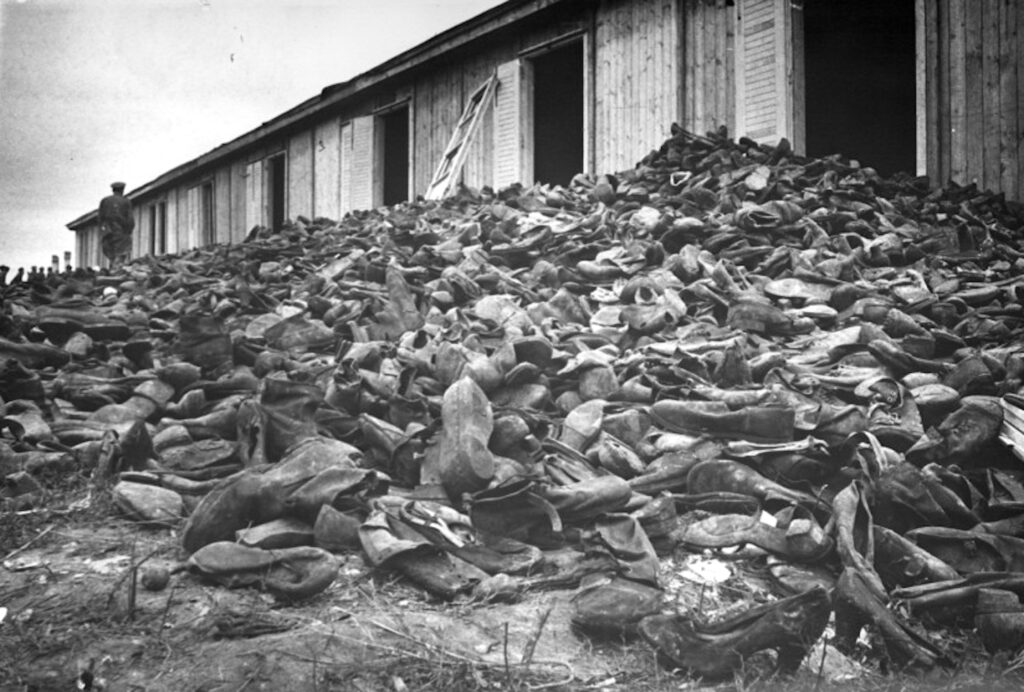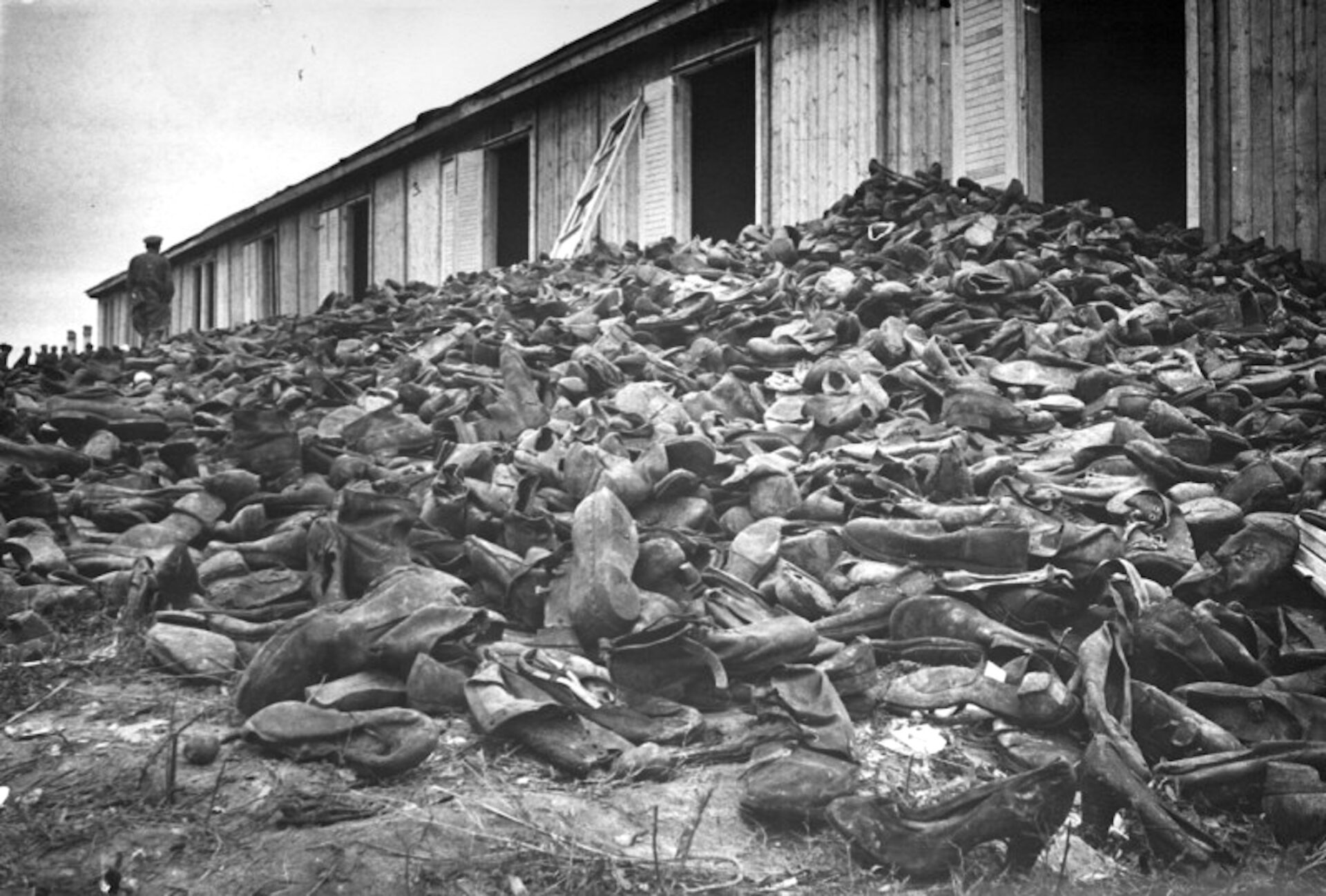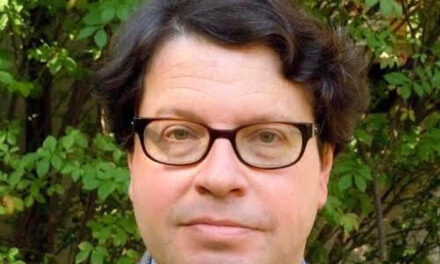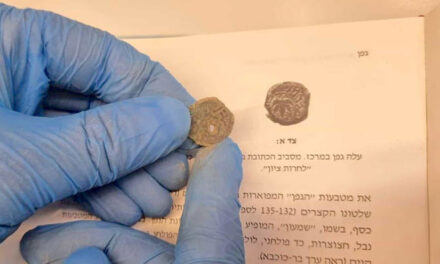By PHYLLIS HEIDEMAN
(JNS)
The Academy Award-winning film “Forrest Gump” begins with the line, “There’s an awful lot you can tell about a person by their shoes. Where they’re going. Where they’ve been.” This line certainly speaks to the harrowing reality of the young children’s shoes amassed at the gates of hell in Auschwitz.
These shoes tell stories that must never be allowed to disappear together with the memory of those who wore them until their untimely death. Even in the face of the hateful words and distorted claims of the Iranian president, these facts must speak for themselves—because the victims, of course, cannot.

Victims’ shoes at Majdanek. A Soviet soldier walks through a mound of shoes piled outside a warehouse shortly after the liberation of the concentration camp in August of 1994.
The majority of these shoes—an array of colors, shapes and sizes—once belonged to Jewish children. These shoes were once new and exciting for those children. Some of them were gifts; some of them were hand-me-downs; some of them were the first pair of shoes the children ever wore—and the last.
What Is Being Saved
The International March of the Living, in partnership with the Auschwitz-Birkenau Foundation and the Auschwitz-Birkenau State Museum, is launching the emergency “Soul to Sole” campaign to preserve 8,000 children’s shoes now decaying in Auschwitz.
The wearers of these shoes were once wide-eyed excited children who used to run, skip and play in them. They sang and danced in them. Many, I imagine, had musical talent or could draw and paint. Others could tell stories from their wild and wonderful imaginations.
Many would have grown up and contributed to the betterment of society. The majority would have eventually become parents and grandparents themselves. They would have loved their children and their grandchildren and undoubtedly would have bought them their own shoes. Many of these children might have saved some of their little shoes to pass down to the next generation. We will, of course, never know.

As a grandparent myself, just writing these words sends shivers through my very soul.
In memory of the innocent little souls who wore these shoes, we are committed to rescue the last remaining physical testimony to their lives—the lives of the 1.5 million children murdered in the Holocaust and especially the 232,000 children brutally murdered in Auschwitz.
No more will these children sing or dance or play. The only tangible shred of evidence remaining of these Jewish children are the shoes they left behind: A collection of silent memories we can never allow to disappear.
Today, as we continue to confront the voices of Holocaust distortion and denial, we are determined to preserve all forms of truth, veracity and memory. As the unspeakable events of World War II drift further and further into the distance, our enemies will have an easier path to their cynical manipulation of the facts. We cannot allow them to prevail in their attempts to deny the past.
Our initiative represents more than mere restoration. It is a statement of tribute and memory. While the lessons of the Holocaust are universal, the event is particular. We will not allow others to rewrite this chapter in our history and create their own narratives that deny truth. We will not forget our ancestors. These shoes represent real lives whose worlds were lost in the flames of hatred. We must never fail to remember them.
Preserving Victims’ Voices
Through this initiative, we will give continuing voice to the victims, along with their hopes, identities and dreams, by rescuing and restoring the evidence. Today, we act to save from extinction the shoes of these precious souls, because it is our moral obligation to remember.
I recently spoke with Holocaust survivor Paula Lebovics, who was deported to Auschwitz when she was only 10 years old. Paula survived Auschwitz but lost her father, who was taken to the gas chamber in Sept. 1944 on the second day of Rosh Hashanah. Her sisters Chaya and Chana were also murdered.
Paula will never forget the moment toward the end of the war when she found mismatched shoes in Auschwitz. She was so proud that she had found two boots. They were not a pair, and one was much too large. “A moment ago I had nothing, now I considered myself rich,” she recalled.
I promised Paula that we would preserve the shoes of the children murdered in Auschwitz.
Phyllis Greenberg Heideman is president of the International March of the Living. Readers interested in helping will find details at the International March Of The Living website.









